
MAY CONTAIN NUTS

Search Shorpy
SHORPY ART

Framed or unframed, desk size to sofa size, printed by us in Arizona and Alabama since 2007. Explore now.
Join and Share
Ad-Free Shorpy
Shorpy is funded by you. Patreon contributors get an ad-free experience.
Learn more.

Recent comments
- Now that's a service station!
- Union Switch & Signal
- Still there -- but not a garage any more
- Must be good breezes there
- Wowzers
- Treescaping
- Still Life With Operator
- +112
- Rear View
- Way in the back --
- Button It Up
- And with an eye on the time ...
- Working in an enclosed ashtray
- Rear View Mirror?
- Tobacco cam
- Basic fact I learned only later in life
- Put a Lid on it!
- Pinstripes in the Tower
- Sound enhancement
- 3438 in '38
- Second Career
- Their days are numbered
- Only the Sensor
- Train control mechanism
- Rarest of the Rare?? & Classy 3400 Class
- Control Mechanism
- Those standpipes
- Wrenches
- International D-40 I believe
- Job prospects
Member Photos
The Shorpy
Printporium
Printporium
Search Shorpy
Search results -- 30 results per page
- Pit Stop: 1940
- ... growing region--I grew up going downstairs almost every night for a mason jar of fruit my mom had canned after buying it for a very ... are probably seeing only treetops and wandering possums at night.
A remarkable number of Shorpy migrant and depression era pictures ... Posted by Dave - 03/01/2018 - 7:37pm -
![Pit Stop: 1940 July 1940. "Migrant fruit workers from Louisiana fixing flat tire along the road. Berrien County, Michigan." Medium format acetate negative by John Vachon for the Farm Security Administration. View full size.
The problem is deeperIf it were just a flat tire, why would he need to touch the wheel hub?
Safety First...or as Mike Rowe from "Dirty Jobs" would say, "It's at least in the Top 10 there somewhere!" I'm glad they have that rock blocking the front wheel to keep that Ford from rolling away. It also looks like they'll be doing this again on down the road. Those tires appear to be the "Maypop" brand. You know, as in "they may POP at any time!"
Brake/break job.This Model A Ford is in decent shape having lost a few items over the years such as horn, center bumper clamp, license plate clamps. Note the license plate was digging into the radiator, so it was moved to the side. The wheels are from a 1930-1931 Ford. This example is the 1928-1929 type, a Tudor in Ford parlance.
Expensive tripLooks like they had to replace the front right tire outright already on this trip. Others look like they're getting their money's worth.
Berrien County is still a good fruit growing region--I grew up going downstairs almost every night for a mason jar of fruit my mom had canned after buying it for a very reasonable price. They're even getting some decent wineries after moving away from growing Concord grapes for bum wines for a long time.
The JobI picked cherries in MI as a kid in the mid 50s. If nothing changed, they make you pick the whole tree (not just the easy cherries), and punched a ticket for every full bucket you gave them.
The punches turned into money when you turned in the ticket.
You could eat as many cherries as you wanted. This didn't turn out to be as many as you might think.
And more to fixlooks like someone lost the little wire clips that hold the headlight lenses in place last time they got new bulbs! With the randomly oriented lenses, they are probably seeing only treetops and wandering possums at night.
A remarkable number of Shorpy migrant and depression era pictures include '28-9 Fords -- they were the national standard for cheap and reliable used cars.
[Also MIA: the passenger-side headlamp visor. - Dave]
The George McFly lightBack when sealed-beam headlamps were secured by two adjusting screws and one strong spring (that is to say, only three decades ago), I used to joke that if you lost the spring, and the headlamp pointed into the treetops, you could spot Marty McFly's dad in time to stop.
Safety rule , avoid pinch pointsI hope that vehicle was blocked up securely and not just held up by a jack . They have a rock under the front right tire to stop forward motion. But judging from the tension on his forearms he's pulling hard on the hub or brake assembly . The rock is not going prevent sideways movement . This is while exposing his legs which are under the vehicle .
No need to remove the wheelOn the Model A (and probably other cars of the period) could change tires or repair tubes without removing the wheel. I've done it a few times.
Joke's on RussiaThe Russian government showed their people the movie "The Grapes of Wrath" so they could see how bad things were in America. Instead, the Russian people were very impressed that even poor people in America owned cars.
(The Gallery, Cars, Trucks, Buses, John Vachon, On the Road)](https://www.shorpy.com/files/images/SHORPY-8b37586a1.thumbnail.jpg)
- Fatal Stroll: 1902
- ... summit house when she expired on that blustery September night in 1855. 5x7 glass negative. View full size.
Still there I ... up late, they still were not at their destination when night fell. Lizzie was wearing the usual apparel for women of her time, ... Posted by Dave - 10/22/2020 - 3:07pm -
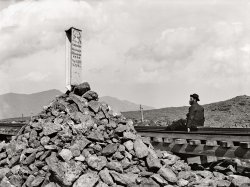
- Munger Motor: 1920
- ... the police were called in. Caros was arrested and last night was being held for investigations.
As punishment for serving macaroni ... Posted by Dave - 08/13/2013 - 3:38pm -
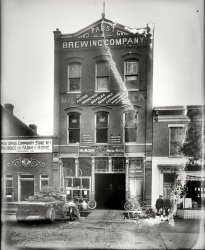
- Hung Out to Dry: 1939
- ... parts of the city where you don't want to be walking at night. And the majority of the buildings date from the late 19th and early 20th ... Posted by Dave - 09/13/2011 - 10:50pm -
![Hung Out to Dry: 1939 April 1939. "Jersey City and Manhattan skyline." 35mm nitrate negative by Arthur Rothstein for the Farm Security Administration. View full size.
You may find yourself living in a railroad flat... right next to the Erie Lackawanna tracks. Those trains cars were still in service until the 1980s, and durable old warhorses they were.
What is most striking - and horrifying - to me is the amount of particulates and soot in the air. I sometimes forget how densely covered with coal soot, diesel exhaust and oil-furnace smog cities would be on an overcast or air-inversion day. It sure didn't help the tubercular. Tuberculosis was still a scourge, and would be until the invention of Streptomycin 5 years later (also in New Jersey, at Rutgers.)
You'd think that with that view of the skyline (when the day was clear), Jersey City would have been a bunch of Manhattan strivers. But it was mainly port guys, Irish longshoreman who would defend their territory with fists and bats. It was as gritty as it looks.
Any Bets?It is a good chance this picture was taken on a Monday. Back in the day that was the day to do the washing, mending, and ironing.
White SalePeople certainly wore a lot of white clothes.
Erie RailroadAs mentioned previously the passenger cars, which were dark brown like the old U.S. Mail boxes and mail trucks, belonged to the Erie Railroad, whose eastern terminal was there in Jersey City. NJ-NYC commuters, like my father, would take the ferry across the Hudson River, weather permitting, and the "Hudson Tubes" subway (now PATH) under the river when the weather was bad. In 1960, the Erie Railroad merged with the Lackawanna Railroad to form the Erie Lackawanna Railroad, at which time they switched their terminal to the Lackawanna facility in nearby Hoboken. One of the most interesting characters in U.S. political history was Frank "I am the law" Hague, who reigned supreme as Jersey City Mayor from 1907 to 1947.
Poor QualityThe shots of '39 Jersey City are interesting in that it appears Arthur Rothstein was 1) using an inferior camera; 2) an inferior lens on a good camera; 3)poor quality film; 4) poor quality development. Be interesting to know which.
There are other photographs by Rothstein using a 35mm camera that are quite up to standard; and his medium and 4x5 works are masterpieces.
[His 35mm camera was a Leica. - Dave]
Jersey SootyWith all that smoke in the air, I'll bet their clothes were gray by day's end. Makes you wonder what the difference was between air quality then and now.
Clothesline pulleysI'll bet if you went to the back windows of those tenements today, you'd still find the pulleys attached to the windows. You can still find the poles in the back yards, and the pulleys on the windows in Brooklyn. All they need are new ropes. A very earth friendly way to dry your clothes!
That's where the well-to-do now liveIn this era, that part of Jersey City is making a comeback as the heir-apparent to well-to-do apartment living. Many of the old factories have been converted to condos, including the former Hague-built Jersey City Medical Center (too far to the west to be in this photo). Most of the buildings in the foreground - the ones that survive - have been converted to apartments, much in the manner of the better areas of Brooklyn that were of the same vintage. Part of the distant area in the photo is now know as Newport Center, and several of the old blocky warehouses are now tony condos for commuters via the nearby PATH into Manhattan. No where near as sooty as it was even in my childhood in the 1950's. I'm trying to find out what that greek-columned building was/is - it looks familiar to me, but I am not sure of the exact location and haven't had any luck finding it on Google - I think it's on Marin Drive or Grove Street, north of the Holland tunnel, just on the JC side before Hoboken. I'll just have to keep looking.
"The muggers are mugging the muggers"Jersey City has always been a dense, gritty city with its share of slums. However, it was a pretty safe city until the 1960s, when things started to deteriorate. My grandfather, who lived in the Greenville section, used to say "Jersey City is getting so bad, the muggers are mugging the muggers." He wasn't far off. While it's a little safer today, there are still many parts of the city where you don't want to be walking at night. And the majority of the buildings date from the late 19th and early 20th century. Fortunately, the misguided highrise public housing projects are coming down (Currie's Woods, Montgomery Gardens), and the JC waterfront is being built up to the point where its skyline has overtaken Newark's as the best in the state. The spillover from Manhattan that started in the '80s to escape the high cost & taxes continues today.
Jersey CityThe intersection at the far left right above the trains is Jersey Avenue & 10th Street. The park is Hamilton Park. The building with the columns is not there any longer. Nor is the building with the kind of cupola adjacent to the park. But you can make out Harborside Financial Center in the distance, that was the key. Most the other industrial buildings in the distance are gone. Photo probably taken from the roof of the Erie warehouse bounded by Coles, 11th, Monmouth, and 12th.
(The Gallery, Arthur Rothstein, NYC, Railroads)](https://www.shorpy.com/files/images/8a10973a.thumbnail.jpg)
- Ruth E. Pember: 1901
- ... radio. The signals were made by flag, semaphore, or by night beacons and a 4 letter code was easier and usually quicker to signal than ... Posted by Dave - 08/05/2012 - 4:27pm -
![Ruth E. Pember: 1901 Circa 1901. "Ruth. E Pember at sail." 8x10 inch dry plate glass negative, Detroit Publishing Company. View full size.
Schooner beachedNew York Times, Dec. 17, 1917.
Schooner Beached Near Sandy Hook
The American schooner Ruth E. Pember was beached early yesterday near the Sandy Hook Coast Guard station after having been seriously damaged in collision with a submerged wreck one and a half miles northwest of the Scotland Lightship. The vessel is 95 tons register, built in 1901 at Tottenville, Staten Island, and owned by John F. Cohn.
So, 95 tons. Would that be the same vessel?
Though are the passing moments frailNothing is so timeless as water and sail.
Hats off to the Photographer!Shooting an 8x10 plate from a boat with a large sailing vessel bearing down on you is NO EASY TASK! Kudos to the snapper! Great photograph!
BreathtakingOur view of photography from a century ago is everyone standing stiffly in the noonday sun. What a great action shot.
A Bit More SpecificAccording to "Merchant Vessels of the United States: (Including Yachts)" published by the U.S. Coast Guard in 1915 her specs were:
Official number 111334
Signal letters KSWR
Rig Schooner
Gross tonnage 95 tons
Net tonnage 58 tons
Length 92.3 feet
Breadth 22.8 feet
Depth 9.7 feet
Crew 20
Built 1901, Tottenville, NY
Home Port New York, New York
Re: Schooner beachedFrom the NYT (undated):
PEMBER - HINE ENGAGEMENT
Announcement has been made of the engagement of Ruth Eldridge Pember, daughter of Mr. and Mrs. Edward E. Pember of Hartford, Conn., to Harold Morton Hine. Miss Pember is a graduate of Vassar College, class of 13, and Mr. Hine was graduated from Wesleyan in 1912. No date has been set for the wedding.
AND from the Connecticut Historical Society comes Harold's obit, on 12/22/41, age 54, leaving Ruth, whom he married 4/18/17, and their son, Thomas, Wesleyan 1941.
So, right, they're all dead except maybe Thomas, who was born in 1919.
Famous Last Words"There's a wreck near this lighthouse, but our centerboard should clear it."
Capsizing SchoonersCostello: "I once had a schooner capsize on me"
Abbott: "What did you do?"
Costello: "Wiped off the bar and ordered another one!"
"Signal letters KSWR"I'm intrigued by this. As far as I know, very few vessels had radio by 1915 (when the Coast Guard record was entered), so any identifying signal letters would have been flown on coloured signal flags. That is, if the boat wasn't already flying its name on a huge banner!
"KSWR" certainly fits the format of a U.S. maritime radio call-sign. Either the government was routinely allocating call-signs to registered yachts by 1915, or perhaps the identifying letter groups used on signal flags were already in this format.
[Lots of ships had Marconi wireless (radiotelegraph) equipment in 1915. And even farther back. The Titanic, for instance. - Dave]
Follow that codAfter floating from Brown's yard in Staten Island, the schooner was fitted with a 50-horsepower gasoline motor at Commercial Wharf in Brooklyn. She went into service as part of the Fulton Fish Market fleet. Captained by F.M. Redmond, who owned her in partnership with John Feeny, she sailed in pursuit of bluefish and mackerel, patrolling seas between Block Island and Cape Hatteras. Redmond was Ruth's uncle.
Re: "Signal letters KSWR"At least as far back as the late 1870s, registered US (and British) vessels were given 4 letter codes as a part of the International Code of Signals. This was, of course, before radio. The signals were made by flag, semaphore, or by night beacons and a 4 letter code was easier and usually quicker to signal than spelling out a name, especially when considering the code flags originally consisted of only consonants. When radio came along, the system was continued and is still in use today.
(The Gallery, Boats & Bridges, DPC)](https://www.shorpy.com/files/images/4a25816a.thumbnail.jpg)
- Vacancy
- The same view from 1960 as below, but at night. Pretty, isn't it? View full size.
Pretty, indeed. And so ...
(Even though I can't look at a motel pool at night without thinking of Clark Griswold in _Vacation_...)
Vacancy ... Posted by Dave - 09/07/2011 - 10:39pm -

- Dacotah: 1940
- ... the 'Kadoka' Hotel. But I definitely stayed someplace that night!
Unmarked I see no traffic control signs, signals or lane ... Posted by Dave - 12/09/2011 - 11:27am -
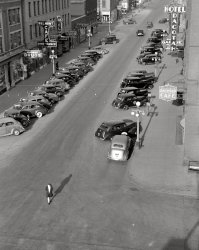
- Royal Street: 1901
- ... tokens; mule-drawn floats, accompanied during the night parades by walking men holding aloft tall poles topped with v-shaped ... Posted by Dave - 08/21/2012 - 5:58pm -
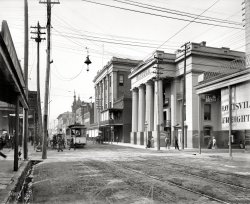
- Sweethearts of Rhythm: 1940s
- ... right in the heart of the Delta, invaded Chicago Saturday night and gave jitterbugs, swing fans and hep cats something to talk about.
... Posted by Dave - 07/29/2013 - 1:59pm -
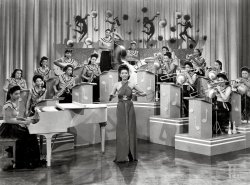
- Hitler's Children: 1943
- ... time before cruising the Times Square area later that night looking for whatever. After the movie ended, the mighty organ could be ... Posted by Dave - 03/20/2013 - 5:00pm -
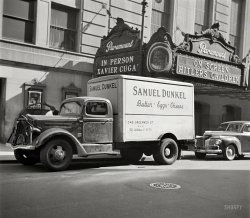
- The Mayflower: 1927
- ... as Client Number Nine; it is also where I spent my wedding night almost 27 years ago.
Senior Trip Thirty years later, the Senior ... Posted by Dave - 08/28/2012 - 6:41pm -
![The Mayflower: 1927 Washington, D.C., circa 1927. "Mayflower Hotel, exterior, Connecticut Avenue." Harris & Ewing Collection glass negative. View full size.
Still a beauty but --Gone is that beautiful canopy at the entrance. Today's version is rather ugly. And the facade has been defaced by cutouts for the air conditioning units.
Mayflower shapeMy guess is that the curved fronts were a clever way to fit a rectangular structure on a triangular lot without winding up with something awkwardly-shaped.
It's interesting to see that the giant urns at the top have survived; usually things like that have been removed lest they fall and bash the brains out of unsuspecting passersby below. I wonder what secured them in place originally, and if it's been subsequently reinforced.
The Escher building?I can't make that building work in my mind. The left, ground-floor front curves, but the rest of the building doesn't. Odd.
[Look again. Both sections curve, and are angled to face the same direction. Who can tell us why? - Dave]
Plus ça changeThe Mayflower Hotel has remained a classy place down through the decades in DC. It has restaurants and nightlife as well.
Curvature of the InnIt's really the street that's angled, not the hotel, except for a small portion of the southern tower. The curved facades (on the left) face due west.
[I would guess that the main goal was to have a floorplan that avoided triangular or trapezoidal guest rooms and corners that were not right angles. - Dave]
The facadeI love the faces on the upper part of the building and how they match the ones a few feet above the doorways.
Mayflower memoriesIn 1987, my husband's uncle came to DC for his 50th law school reunion at George Washington University. He stayed at the Mayflower because he had lived right across the street while he was in law school and he knew that meant he could walk to the campus for the reunion activities.
He told us that his younger brother (my husband's dad) had stayed with him for awhile and used to take his car without his permission.
"I guess I used to leave the keys in the car," he said, pondering how his brother would have the opportunity to just jump in and drive away.
Also... the Mayflower isn't only famous for being one spot where Elliot Spitzer was known as Client Number Nine; it is also where I spent my wedding night almost 27 years ago.
Senior TripThirty years later, the Senior Class of 1957, Lynn View High School, Kingsport, Tennessee, would make this hotel our base for the visit to Washington.
Starting a fashion trendThe guy standing next to the luggage near the front entrance to the hotel. He is a hatless rarity for this time period on Shorpy.
Everything old is new againA website photo of today's Mayflower Renaissance Hotel.
Stayed there in '87Beautiful place then and looks beautiful now.
View Larger Map
(The Gallery, D.C., Harris + Ewing, Streetcars)](https://www.shorpy.com/files/images/20785a.thumbnail.jpg)
- Bottle Club: 1909
- November 1909. "Some of night shift waiting to go to work. Cumberland Glass Works, Bridgeton, New ... Posted by Dave - 08/13/2013 - 3:59pm -
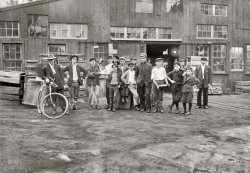
- Larry's Beer Garden: 1934
- ... a contender ... now I'm just a bum who gets blotto every night at Larry's Beer Garden." I knew guys like this, they worked very hard ... Posted by Dave - 09/13/2011 - 1:59pm -
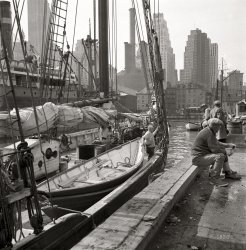
- The Big Shot: 1957
- ... a more peaceful version than the original.
"Saturday night, two cars at a light, in the backseat there was some film;
Words were ... Posted by tterrace - 01/16/2021 - 4:16pm -
![The Big Shot: 1957 I never did get the full skinny on how it all went down that day. All I know is that it was my brother and his pal, this guy. A couple of ex-Catholic high school boys; you know the type - four years in, walk out with a fancy piece of paper, the whole nine yards. Then two years later they're back in town, cruising the mean streets, past all the usual joints - Montgomery Ward, J.C. Penney, F.W. Woolworth, Thom McAn, The Cottage Bookshop. That's right: San Rafael, California.
When it happened, it happened fast. First his pal pulls up and parks, lights himself a cig, happy as a clam, not a worry in the world. Then my brother hauls off and shoots him with his Lordox, a German 35mm job loaded with Kodak Tri-X. For years afterwards my brother keeps this pic pasted in a book or something. What a crazy guy. View full size.
Narration by Joe FridayThis could only get better by being read by Jack Webb.
Que j'en ne sais quoiIt's a shame cigarettes are so unilaterally bad for your health. As every lover of film noir knows -- they're great at helping set the mood and represent feelings not spoken.
The way I read this scene: he's counting the dough in his wallet, you can see his hands reflected in the side panel, figuring out how much he can blow on his babe. The photographer is wondering how soon the ash is gonna fall off the cig.
A mysterious caper alrightForget it, Jake, it's San Rafael.
I Feel A Song Coming OnI can't help but be reminded, by both the setting and description, of the words to "My Hometown," however, I offer a more peaceful version than the original.
"Saturday night, two cars at a light, in the backseat there was some film;
Words were passed, didn't use a flash, picture time had come ... to my hometown."
Very well, I'll see myself out ...
Which X?It looks more like Plus-X grain. Tri-X is a bit coarser.
[From the evidence locker. - tterrace]
Down those mean streets ...... a man must go who is not himself mean, who is neither tarnished nor afraid. ... Must be a complete man and a common man, yet an unusual man. He must be, to use a rather weathered phrase, a man of honor."
Evidence missing from this "Big Shot" case.Found Leidolf Lordox 24x36 German made camera!
1947 or 1948Plymouth convertible from what little I can see of the steering wheel hub.
[Buick Roadmaster seems to be the current consensus. - Dave]
A hidden truthThank you, GlenJay, for invoking the immortal lines by Raymond Chandler. I sent that entire quote to my son once. I thought it worthwhile that he should read it.
"Down these mean streets a man must go who is not himself mean, who is neither tarnished nor afraid. He is the hero; he is everything. He must be a complete man and a common man and yet an unusual man. He must be, to use a rather weathered phrase, a man of honor -- by instinct, by inevitability, without thought of it, and certainly without saying it. He must be the best man in his world and a good enough man for any world.
"He will take no man’s money dishonestly and no man’s insolence without a due and dispassionate revenge. He is a lonely man and his pride is that you will treat him as a proud man or be very sorry you ever saw him.
"The story is this man’s adventure in search of a hidden truth, and it would be no adventure if it did not happen to a man fit for adventure. If there were enough like him, the world would be a very safe place to live in, without becoming too dull to be worth living in."
Mean Streets? San Rafael ?!?Not only the year I was born, but my home town and referencing the high school I attended.
I think the meanest things down on 4th was the courthouse fire - remember looking at it the next morning on my way over the hill to St. Raphaels and it looked just like a bag of burned McDonalds fries.
After the movie came out, the biggest crime was taking 10 minutes to go a block, given all the cruisers. Mean streets?
[As noted below, "mean streets" is a continuation of the Raymond Chandler literary trope employed by tterrace in his post. - Dave]
Before getting his first carI think this fellow stole Pee Wee Herman's bicycle.
But it's no LeicaFound a Lordox in my local thrift store a few days ago.
(ShorpyBlog, Member Gallery, tterrapix)](https://www.shorpy.com/files/images/0829_SHORPY.thumbnail.jpg)
- Game ON: 1952
- ... now. My own relatives played penny poker every Saturday night, but had booze on the table instead of candy. Good times.
Wall ... Posted by Dave - 08/08/2014 - 11:05am -
![Game ON: 1952 "Card game at Floyd's -- Feb. 11, 1952." In this latest episode of Minnesota Kodachromes (or is it a Mama's Family prequel?) we have, going clockwise from lower left, Dottie, Ivan, Grace, Rach and Floyd playing Rummy Royal, with the empty chair belonging to Hubert, who took the picture. View full size.
Tripoley!As I knew it as a kid, also known as "Michigan Rummy". One of my favorite card games, very simple rules and we used to play with pennies instead of chips. The 8, 9 & 10 all one suit always had the biggest pot and when you would finally "cash in" after winning that pot, you would have this giant pile of pennies in front of you and your opponents would stare you down!
Perfect example by the look on Rach's face, I'm guessing someone just won it!
Rach and Dottiemust be partners and Dottie's not feeding the right cards to her!
By the way, I can clearly see the Mr. Goodbars in the far candy dish. I'm sure that Krackel, Special Dark, and regular Hershey bars are hiding in there somewhere!
Majority preferred printsCan't help but notice that everyone in the game except for Grace is wearing printed fabric and of course the home decor is a colorful riot of busy prints as previously mentioned. As for the comment from Root 66 regarding the Hershey miniatures, you younger people may not know that in those days, even these tiny ones had two-piece wrappers, a paper sleeve outside of a separate foil inner wrap (like a stick of gum). I'm not sure the "special dark" existed in 1951 but it's my favorite now. My own relatives played penny poker every Saturday night, but had booze on the table instead of candy. Good times.
Wall paper, curtains, upholstery, Ivan's shirt ...Are you sure this photo didn't appear in "Architectural Digest?"
DoiliesI just noticed the needlework doilies on the chair backs. My mom used to do that. It kept her busy for days on end during the Minnesota winters.
[Those are antimacassars. -tterrace]
Word of the DayThanks tterrace, antimacassar has to be my new word for the day. I wore a Navy uniform for a number of years and I never heard that term before today.
Decor Notes1. Antimacassars & doilies.
2. Floral everything.
3. Lampshade identical to this one at Grace & Hubert's.
4. Chair the same shade as their couch.
5. Doilies & antimacassars.
Below: "Rach & Boots at Floyd's," taken the same day.
More interested in the dish than the potThe card game host, "Sweet Tooth" Floyd, is on track to empty the candy dish at his left elbow. The flash caught him with his mouth wide open, ready to receive the sugary treat in his right hand.
"Crummy Royal"In the late '50s it was a game my folks and friends played along with cribbage. Sometimes I got to join in and whoever was losing renamed the game to Crummy Royal.
Prints-tonNow that we've been treated to views of riotous wallpaper and drapes inside two separate Tuttle homes in the city of Blue Earth (Hubert and Grace's place in the shot of Leslie Boler, and Floyd and Dorothy's place with the card game), I must wonder how many other Blue Earthers of that period were surrounded by floral prints on virtually every vertical surface. Main-street small-town decor shops rarely offered much variety.
ConservativeMy parents were much more sedate; they played canasta with the neighbors.
(Minnesota Kodachromes)](https://www.shorpy.com/files/images/SHORPY-MNK195A.thumbnail.jpg)
- Comfy Slippers: 1921
- ... to keep cold (I remember doing that in college, until one night it got too cold and I ended up with a beersicle). On the top floor of the ... Posted by Dave - 09/04/2012 - 9:36pm -
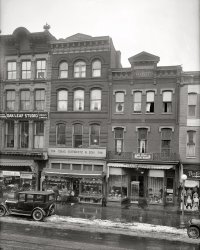
- Motive Power: 1926
- ... were about 100 yards away and several times during the night we would wake up to a passenger train just passing through. We could see ... Posted by Dave - 05/21/2016 - 3:05pm -
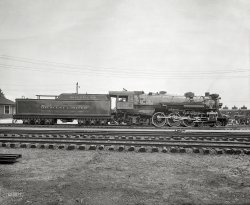
- Massey Mill Boys: 1913
- Columbus, Georgia. April 1913. "Night Work! Group of boys, all working in Massey Hosiery Mills. Most of them ... 11 yrs. old been working one year part of the time at night. Lawrence Webb, 12 yrs. Old. Jack Wright, 15 yrs. working three yrs., ... Posted by Dave - 09/08/2011 - 7:22pm -
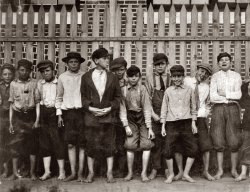
- Eight Is Enough: 1924
- ... on Jay Gatsby's giant patio as jazz laced the Little Egg night.
No Lampshade? Whatever they had in the punch, it was effective. ... Posted by Dave - 09/04/2012 - 4:55pm -
![Eight Is Enough: 1924 November 18, 1924. Washington, D.C. "Debutantes of Columbia Hospital Benefit Committee." National Photo Company Collection glass negative. View full size.
Miss front row, 2nd from left....."Isn't that a great photo of all of us"?........the other 7..."Grumble, grumble, grumble, grumble........."
"The color of truth is gray"It was so much fun colorizing the Canning Club photo that i thought i'd have a go on these ladies amazing costumes .. please enjoy.
[Fantastic! Click for fabulous enlargement. - Dave]
My Oh MyLessee, Carmen Miranda, a freckle-faced Arab and a dunce cap, no less. I am at a loss for words on this one. Imagine this scene today.
End to EndBill M, you know what Dorothy Parker said (was it about debutantes in general or Bryn Mawr girls in particular) about if they were laid end to end ... she'd be surprised. Is that you were referring to? In this case (I'm ashamed to say it, as I'm not as bold as Dorothy Parker) I would definitely be surprised!
[I think Dorothy said the opposite -- she wouldn't be a bit surprised. Otherwise, not much of a joke. - Dave]
ColorizingYou have done a fabulous job colorizing this picture and the Canning Club photo. What software do you use? I have been very interested in colorizing old family photos. I really like the look of old b&w photos with some color and would like to be able to create it.
Who's whoat the Drag Party?
Second row - second from right = John Lennon
First row - second from right = TE Lawrence
Bal de Tete
Washington Post, Nov 28, 1924
Capital Society Events
Interest is growing in the Bal de Tete for the Columbia Hospital to be held at the Willard Tuesday.
Despite that a certain museum will be temporarily depleted of its treasures for the occasion, almost priceless hair ornaments removed from family vaults, heirlooms taken from attics and old trunks redolent with the odor of lavender and moth balls, there is a very close rivalry in the exhibition of all descriptions at Mrs. Hagner's social bureau at the Willard. These creations were made by the debutantes headed by Miss Beatrice McLean, and the proceeds of the sale will be added to the funds for the hospital.
...
Washington Post, Dec 3, 1924
Bal de Tete at Willard
The bal de tete at the Willard last evening for the benefit of the Columbia hospital fund was not only one of the most successful functions socially, but one of the most colorful of the many charity balls held here in many seasons. Various kinds of headdresses were worn, ranging in type from the simple Dutch cap to great crowns encrusted with reproductions of crown jewels. Graceful and extravagant headdresses of feathers, pearls, gold and silver cloth, were worn with dignity by society matrons, while the debutantes achieved great beauty with Spanish mantillas, bandeaux and other interesting ornamentations.
...
Speak easy, girlsI know it was the Prohibition, but several of these girls look more than a little pie-eyed to me.
Deb CynicismPardon my negativity, but I'd like to join Dorothy Parker and other deb-needlers by saying that if you were to change the caption to "Photo by Diane Arbus", it would put a whole new light on this one.
What Jay SawI fantasize that these faces were seen on Jay Gatsby's giant patio as jazz laced the Little Egg night.
No Lampshade?Whatever they had in the punch, it was effective. Especially on the one front row left.
Water Based PhotoshopBasically the only software that i used to colorize those photos was Photoshop. If you want more information on the techniques i used you can email me at pmadcow@comcast.net
(The Gallery, D.C., Natl Photo)](https://www.shorpy.com/files/images/12617u.thumbnail.jpg)
- Metropolis: 1910
- ... Detective Agency Somehow I hope that was red neon at night:
Cosgrove's
D-E-T-E-C-T-I-V-E
Agency
Cosgrove's
DETECTIVE ... Posted by Dave - 07/18/2012 - 3:39pm -
![Metropolis: 1910 New York and the East River circa 1910. "Looking east from the Singer Tower." 8x10 inch dry plate glass negative, Detroit Publishing Company. View full size.
There's always another oneThe traffic on the Brooklyn Bridge, and some previous pictures, showing streetcars less than a block apart, lends credence to the old saying "Never chase girlfriends or streetcars, there's always another one coming right along." Not so true with today's bus systems.
Cosgrove's Detective AgencySomehow I hope that was red neon at night:
Cosgrove's
D-E-T-E-C-T-I-V-E
Agency
Cosgrove's
DETECTIVE
Agency
BMWIn this beautifully busy picture we have the three Lower Manhattan bridges, From south to north or from the bottom of the photo to the top we have The Brooklyn Bridge (opened 1883), The Manhattan Bridge (opened 1909) and The Williamsburg Bridge (opened 1903). An NYC Tour Guide once told me that the easiest way to remember the order of the 3 Bridges is to think of the luxury automobile brand, BMW.
Rogers & Pyatt ShellacUpper rt corner on the NY side ... out of business three years later.
["Shellac in Receiver's Hands" -- sounds messy. - Dave]
RooftopsAnd not an air conditioning unit in sight.
Fletcher's CastoriaThe number of advertisements for Fletcher's Castoria between the Brooklyn and Manhattan bridges is amazing. Talk about saturation marketing.
Brand spanking new!Standing tall in the middle of Brooklyn is the Prison Ship Martyrs' Monument, in Fort Greene. I used to pass this obscure object all the time. Several years ago this extremely out of place memorial piqued my curiosity and I had to do a little research. Around the time of the Revolution people were detained in nearby ships for "crimes" such as not pledging allegiance to the king. It was built in 1908 and magnificently stands over one of the ugliest sections of Brooklyn. Considering that I doubt even one percent of the people who see it daily, are aware of it's its significance, I'm surprised it still stands!
PearlA glimpse of the elevated rail line on Pearl Street.
(The Gallery, Boats & Bridges, DPC, NYC)](https://www.shorpy.com/files/images/4a23362a.thumbnail.jpg)
- KP: 1942
- ... would have been pursuing the EM's obligatory Saturday night debauch and it is better to segue into a hangover in a sentient state ... Posted by Dave - 05/19/2013 - 7:40pm -
![KP: 1942 September 1942. Fort Belvoir, Va. "Army Sgt. George Camplair on kitchen police duty." Our first example of the more than 200 photos shot by Jack Delano documenting this soldier's induction, training and home life. View full size.
What did he do to deserve this...In my 38 years Canadian service (mind you, KP in garrison disappeared in the 80s) only junior ranks normally did KP - I recall a Master Corporal (about E6 equiv) doing it as a result of 'extra duties', & even Corporals didn't do it very often (only tended to happen when there was a shortage of available privates). Never really minded it myself; other then the drudgery of the work, it could be a nice break from route marches & inspections.
Lights, camera, pose! Potentially Delano's hand top left corner holding light - either Delano or it's the lighting guy.
Peeling potatoes was the easy part.The hard part was getting up a 4:15 in the morning. Did not relish the 14+ hour days required for KP. I volunteered for a second Vietnam tour, and one of my main motives was the avoidance of KP.
RHIP (I always thought)I was just wondering if Mr. Delano meant to say Private Camplair. I pulled plenty of KP as a junior enlisted man, but left all that behind when I made Sergeant. And while I normally wouldn't comment on somebody else's comments, that's about the dumbest reason I ever heard for someone volunteering to go back to Vietnam.
[He's a sergeant. As for the commenter you're referring to, Bill is an Academy Award winning cinematographer with three Oscars to his credit. - Dave]
OnionsMethinks they're onions. But where is he putting the peeled ones? Either he's throwing them into the sink (a dodgy plan, given that there's a can of scouring cleanser in the sink corner) or the photographer who staged the photo grabbed a colander of peelings from somewhere else in the kitchen, stuck a peeled onion in Camplair's hand, and didn't think through the rest of the process.
[Everything is going into the colander. (Comment moderator rule of thumb: Beware "methinks.") - Dave]
Sorry, Dave! I'm a scholar of the Renaissance, so the word "methinks" comes as a natural bit of irony--but I can see how it would get massively overused in online forums. In fact, I can see how it might sound to others as bad as "The Bard" sounds to me. I promise never to use any more period phrases on Shorpy!
Is that all?We had to fill garbage cans full of peeled potatoes when I had KP in the 60s.
Typical Institutional KitchenIn the early 70's, I worked for a company that did Heating and Refrigeration repairs. We serviced a number of institutions that had kitchens of this vintage. I took one look at this black and white photo and knew that the tile walls were most likely a shade of green along with the floor. I also remember the various prep tables and sinks - some with wood frames and some with pipe frames - that were probably strong enough to drive a car over. Coffee pots, mixers and even refrigerators were still in use [although the refrigerator cooling had usually been upgraded with new compressor units]. I suspect that some of these kitchens still look the same today.
Trust meSergeants never, ever pull KP.
A Hallowed Mess (Hall)I believe that in my enlisted days I pulled KP in that very same mess hall, surrounded by the very same appliances and furnishings, and perhaps using that very same colander. Allowing for standardization that prevails in government construction, the rectangular patch of slightly different floor tiles is so familiar as to lay a pall over my heavy heart. It would have been in the old brick barracks on main (or South) post Ft. Belvoir, still very much in use in 1960-61 when I soldiered there. KP well and truly sucked: the cooks were surly and unreasonable, much time was wasted polishing that which could never shine and cleaning that which was about to be re-sullied, and seeing how one's food was actually prepared diminished the appetite for days afterwards. And in my particular unit, KP started at 0400, meaning that the CQ awakened the victim at 0330 hours. If you had Sunday KP, it made sense just not to go to bed at all, given that you probably would have been pursuing the EM's obligatory Saturday night debauch and it is better to segue into a hangover in a sentient state than awaken after an hour's sleep to one.
Believe these pics were taken when he was a private.The lower picture shows him as a staff sergeant. No way would a staff sergeant pull KP unless he was being punished for a transgression. Heck, during WWII staff sergeants would more likely be mess sergeants or possibly running the mess hall.
Onions are a horrorOn KP at Parris Island in 1965, another Marine recruit and I peeled a 50-pound bag of onions. After a while your tear ducts dry out and you can keep going with dry burning eyes.
(The Gallery, Jack Delano, Kitchens etc., WW2)](https://www.shorpy.com/files/images/SHORPY_8d22308a.thumbnail.jpg)
- Miss Jane: 1923
- ... Medal of Honor for his captaincy of the USS Chester in a night landing in 1914 at Veracruz, Veracruz, Mexico.
Moffett served as the ... Posted by Dave - 09/04/2012 - 12:59pm -
![Miss Jane: 1923 "Miss Jane [illegible], 1923." One of three images of Miss Jane in the archive. Who will be the first to identify our mystery aviatrix? National Photo glass negative. View full size. [The answer: Stanton Square reveals her to be Janet Moffett, daughter of Rear Admiral William Moffett.]
Forget JaneWho can identify the airplane?
Jane Moffett?The April 22, 1923 edition of The Washington Post features a portrait of Jane Moffett. The daughter of Admiral Moffett, she is noted as being "an enthusiastic airplane fan."
UPDATE: Jane was more formally known as Janet Moffett. The pages of the Washington Post have numerous mentions of her including photographs of her in aviatrix garb and standing alongside a plane.
[Indeed it is! Once again Stanton Square comes up with the answer. - Dave]
Jane's planeA Dayton Wright TW-3
Admiral MoffettAlthough Moffett never learned to fly himself he was known as "the Air Admiral" as a result of heading the Navy's Bureau of Aeronautics. In this post he fought successfully against the Billy Mitchell and the concept of amalgamating the Army Air Corps and the Navy's own aviation program as had been done in Britain with the Royal Air Force. Moffett died in 1933 in the crash of the airship Akron. His son - Jane's brother William - was also an Admiral.
Moffett Field NASMoffett Field Naval Air Station in California was named for Admiral Moffett after his death in 1933.
http://en.wikipedia.org/wiki/Moffett_Federal_Airfield
Aviation seems to have been a strong force in the Moffett Family.
Moffett Airfield and Hangar OneIncidentally, that Moffett Field link is worth looking into for aviation and architecture buffs alike. Moffett Field in Mountain View, CA, is home to Hangar One, an enormous structure built for the construction and housing of dirigibles, including the aforementioned (and unfortunate) USS Akron.
You wouldn't happen to have any nice photos of Hangar One now Dave, would you?
[I'll put that on my to-do list. - Dave]
The Family TreeJanet Whitton Moffett (whom you call "Jane")was born May 17, 1903 in Germantown, Pennsylvania, the daughter of Rear Admiral William Adger Moffett and Jeanette Beverly Whitton (who was affectionately known as "Pete").
Admiral Moffett (see http://en.wikipedia.org/wiki/William_A._Moffett) received a Congressional Medal of Honor for his captaincy of the USS Chester in a night landing in 1914 at Veracruz, Veracruz, Mexico.
Moffett served as the Secretary of the Navy's Bureau of Aeronautics from its creation in 1921. In that role, Moffett became known as the "Air Admiral" for his leadership in the development of tactics for naval aircraft, and the introduction of the aircraft carrier. While he never learned to pilot a plane, Moffett was a tireless advocate of Naval Aviation (including the ill-fated development of dirigibles) and is sometimes referred to as "The Father of Naval Aviation."
JWM married a naval aviator, Lt. Elliott McFarlan Moore, on February 12, 1926. By 1933, EMM was the General Manager of the Wilmington-Catalina Airline, Ltd. (“WCA”), a small airline on Catalina Island founded in 1931 by William Wrigley, Jr., a close friend of Admiral Moffett. Using amphibious seaplanes, the airline shuttled passengers between the Port of Los Angeles and Hamilton Cove on Catalina Island.
JMM was widowed on November 2, 1933 when a seaplane piloted by Walter L. Seiler, the Chief Pilot of the Wilmington-Catalina Airline, crashed on takeoff while conducting an experiment in "flying blind" about a half mile offshore from Catalina Island.
By then JMM had three children: Janet Moffett Moore (my mother), William Moffett Moore, and Elliott McFarlan Moore, Jr.
(The Gallery, Aviation, Natl Photo)](https://www.shorpy.com/files/images/09036u.thumbnail.jpg)
- Grand Entrance: 1952
- ...
My honeymoon hotel The Mark - where I spent my first night of my honeymoon only 2 years after this was taken. We had that suite seen ... outside glassed wall garden. I think it was $75 or $100 a night which back then was an extraordinary amount of $ to spend on a hotel ... Posted by Dave - 07/05/2016 - 9:57pm -
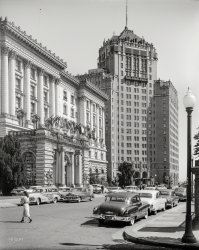
- Recreational Slugs: 1942
- ... I was seven in 1960. My Catholic parish held a Father-Son Night, and for some reason the fathers in charge decided that boxing matches ... everyone, because that was the first and last Father-Son Night. They did Mother-Daughter Nights thereafter, and they were still doing ... Posted by Dave - 04/20/2022 - 12:13pm -
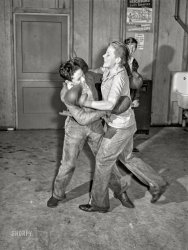
- Babe in the Wood: 1953
- ... a sweatshirt and the old ones cover the three housecats at night so they don't catch a chill.
Impressive Boles! Marilyn is not too ... Posted by Dave - 01/03/2014 - 6:46pm -
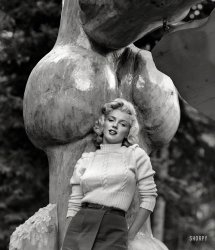
- The Late Show: 1958
- Oakland, California, circa 1958. "Car crash, night." Mercury vs. Buick in a well-attended bout. 4x5 acetate negative from ... how many people would jump out bed in the middle of the night and, clad in only their pajamas, amble out into the street to gawk at the ... Posted by Dave - 09/02/2015 - 11:33am -
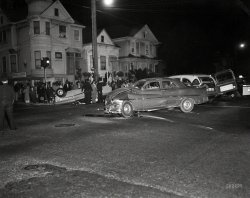
- Union Station: 1928
- ... the station to the left.
Timing Funny, just last night I was looking at the now dilapidated ornate cast iron columns that hold ... Posted by Dave - 01/12/2013 - 11:52am -
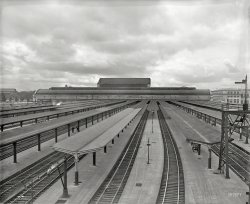
- Mulberry Bend: 1905
- ... Mr. Bacigalupo will rent you his coaches any time, day or night... so long as they don't contain one of his "customers". Apparently a ... Posted by Dave - 02/09/2013 - 9:42am -
![Mulberry Bend: 1905 Circa 1905. "Mulberry Bend, New York City." The name was changed to Columbus Park in 1911. 8x10 glass negative, Detroit Publishing Co. View full size.
What if you were an UNpopular undertaker?Did that mean you had to take Chas. Bacigalupo's leftovers?
The Popular UndertakerPeople must be dying to meet him.
Baciagalupo storyHere's a short story on Chas. Baciagalupo's own funeral from the New York Times in 1908:
"Charles Bacigalupo, who for thirty years has buried the rich and poor of Mulberry Bend and Chinatown, was himself buried yesterday, and no funeral of such a scale of grandeur has ever been offered to the reverent if color-loving and emotional people of that section. Bacigalupo died in Brooklyn in one of those comfortable, old-fashioned mansions in Second Place... There were more than 200 carriages and seemingly endless processions of Italian societies with banners draped in crepe and bands sonorously sounding dirges that kept the mourners' tears welling to their eyes.
"After the services at the house the coffin was brought to the hearse—not the famous automobile hearse, but the finest that was ever built to go behind horses. Then six jet black horses, draped in white netting that flowed over the pavement, started toward the Brooklyn Bridge with six attendants holding their bridles. Behind the hearse were nine open carriages piled high with the flowers that the dead undertaker's hundreds of friends had sent."
Mr. Bacigalupobelieved in the phrase it pays to advertise. Apparently he also has his name & addresses etched under a relief at the Most Precious Blood Church. Here's a very good link that gives backround on "The Popular Undertaker".
The buildings to the left are all gone, now the Manhattan Detention Complex. The building left of center with the large flagpole on the roof is still there (106 Bayard Street).
The Other HalfThis spot is the stuff of dark legends, as mythic a place as exists in New York. It once skirted the eastern edge of the Collect Pond, the fresh water supply of the Dutch and English settlements, and later marked the 12 and 2 positions of the Five Points, with the notorious alleys of Mulberry Bend, immortalized by Jacob Riis, burrowing inward from the street. The efforts of Riis and others brought about the demolition of the entire block between Mulberry and Baxter Streets. The park, designed by Calvert Vaux of Central Park fame, opened in 1897. The manicured ovals are long gone, replaced by basketball courts and playgrounds, but the pavilion remains, nicely restored in 2004. As the signage in the photo indicates, this was part of Little Italy 108 years ago, but is now firmly within Chinatown.
It's Chinatown JakeThe parkhouse still stands. The foreground is now mostly basketball courts.
The street on the left is Baxter Street. The buildings on the left, on the other side of Baxter, were replaced by the NY County District Attorney's office (1 Hogan Place) and NYC Criminal Court.
The street on the right is Mulberry Street. Yup, THAT Mulberry Street. The buildings on the right, on the other side of Mulberrry, are in Chinatown. The buildings in the farground, beyond the parkhouse, are in Little Italy. Little Italy has steadily been shrinking as it is subsumed by the expanding Chinatown.
Very close by was the infamous Five Points neighborhood and Collect Pond. Very much a "Gangs of New York" area in the 1800's. The pond was filled in after it became too polluted. The famous NY County Supreme Court (60 Centre Street -- where Chris Kringle had his trial in Miracle on 34th Street) would one day be close by on the left. To this day it has pumps in the basement working 24/7 to keep the water that used to flow into the pond from flooding the basement. So do several other buildings around the old pond site.
Five PointsAnd a shot of the notorious Five Points neighborhood, probably the toughest worst neighborhood in America ever, at least in the 19th century. At this point we are around the time of the Five Points Gang war with the Eastman Gang. Johnny Torrio and Al Capone were getting their start with Five Pointers at the time of this picture.
Not a school dayI have never seen so many children in a Shorpy photo before. Looks like this park is where they congregate. Has to be better than a tenement. From what I can tell 99% are unsupervised by an adult. Different times: when even small children improvised their own games and entertainment.
Keep them assets earnin'Mr. Bacigalupo will rent you his coaches any time, day or night... so long as they don't contain one of his "customers". Apparently a common practice... several years earlier, the couple responsible for the 1897 NYC "murder of the century" hauled away the decedent by hiring a wagon from their neighborhood undertaker. A touch of irony, in that case.
RegardlessEven if your comment isn't posted, others might still answer your questions. Glad to see that the pavilion is still there. Shame the park is now converted into so many basketball courts [nothing against basketball, you understand], but it would be nice to have the greenery.
SnoozingI notice several gents having a nap while sitting on the benches. When I was younger, I couldn't understand how you could sleep sitting up like that. Now I wonder how you don't. Embarrassing in restaurants. Ahem.
All in Chinatown NowThe buildings right behind the park pavilion are all in Chinatown now, and have been since at least when I lived in the area in the 60s and 70s. There were only a handful of longtime Italian businesses and families I knew left there on Bayard and Mulberry Streets. The tourist trap of restaurant after restaurant that is Little Italy now doesn't begin until north of Canal Street, running up Mulberry Street for about a half mile or so.
By the way, the building with the flagpole and flag to the right of center is 70 Mulberry Street, formerly Public School 23, and now the Research Center location of MoCA, Museum of Chinese in America.
(The Gallery, DPC, NYC)](https://www.shorpy.com/files/images/SHORPY_4a12691a.thumbnail.jpg)
- Darken My Door: 1943
- ... you would put blankets over your windows during the night. Less frequently used windows (such as in basements) would have had ... had people assigned to check for any stray light leaks at night.
Re: Heavy Drapes I'm not quite old enough to remember the War, ... Posted by Dave - 11/04/2013 - 5:27pm -
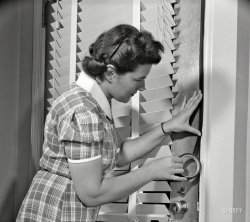
- The Party Committee: 1943
- ... tubes indicate that much at least. Looks like it was a fun night though, records everywhere, much the same at my house to this day after a ... Posted by Dave - 09/09/2011 - 11:33am -
![The Party Committee: 1943 December 24, 1943. Washington, D.C. Christmas Eve party given by Local 203 of the United Federal Workers of America, Congress of Industrial Organizations. View full size. Medium-format safety negative by Joseph Horne.
Okay, I'm old enough to knowOkay, I'm old enough to know those are records (or LPs as some call them). But what is that box in the middle with the three dials and the vents on it? Some sort of amp or speaker?
TK
I'm young enough to know...That those are records as well. They haven't disappeared and actually they're making a comeback of sorts at least here in the UK. Anyhow, those ladies are ready to party and I believe the box you're referring to looks like an tube amp used to power the speakers. The slots and heat vents on the sides for the vacuum tubes indicate that much at least. Looks like it was a fun night though, records everywhere, much the same at my house to this day after a party and I bet the lady on the right was just about to ask the DJ to keep an eye on her bag while she went for another whirl on the dance floor.
AmpThat looks like an amp--you can see the speaker in the top right corner of the photo.
RecordsI don't know what that item is, but I'm pretty sure those records aren't "LPs". They're probably 78 rpm records, which were 10" or 12" but only contained one song on each side. 33 1/3 rpm "long playing" records with five or six songs on each side came along years later.
[Long-playing 33 1/3 rpm records -- LPs -- made their debut in 1948. - Dave]
The stuffThe box with three knobs is a PA amplifier. Typically these were used for announcing stuff as well as playing records. they had a microphone input or two and a phono input. That looks like a loud 20 watt one.
The upper right corner shows a speaker in a home-made mount. Apparently the builder didn't know that speakers work a lot better bass-wise when put in an enclosed box.
LPs and 45sIt wasn't a case of the recording companies being unable to make up their minds, it was a good old fashioned format war caused by a rivalry between companies (see Sony's Betamax vs JVC's VHS, or Sony's Blu-ray vs Toshiba's HD-DVD). The LP was developed by Peter Goldmark at CBS with the first releases coming in 1948. The early notion was to be able to have complete pieces of classical music on a single side (as opposed to having to change the record every four minutes or so). The 45 (the one with the big hole) was developed at RCA Victor. The purpose of the big hole was supposedly to accommodate an automatic changer mechanism, but it also meant that you couldn't just modify your old 78 record player, you had to buy an entirely new machine...from RCA Victor. Apparently CBS offered to share the LP technology with RCA but the personal animosity between CBS boss William Paley and David Sarnoff was so great that Sarnoff rejected the offer.
The 45 was a direct replacement for the 78s we see in this photo - lighter and less prone to breakage (and ideal for radio stations because there's a single song on each side) but the LP, which was roughly the same size as the 78 won the war.
I'm even older, I guess...Those aren't "LP's", they are the ancestors of LP's. They are what we called "78s's"....records that played at 78 rpm. They only held one song per side. A bunch of these could be gathered into a booklike "album" with a several sleeves that held, maybe 12 songs. The term "album" persisted in the 50's when the new vinyl 12 inch records came out. These played at a much slower 33 1/3 rpm so 6 or more songs per side were possible - a whole album could now be put on one record. It was these that came to be called LPs, for long-playing. "Singles" in the LP era were smaller, with one song per side, and played at 45 rpm. (They were the ones with the big hole in the centre - then, as now, people in the recording business had trouble deciding on universal formats. Records came in other sizes too)
45s and holesThe record changer system worked really well. You could stack up to ten 45s on the spindle and they'd drop down, one at a time, to play. The main reason for buying new players was the speed. Most (all ?) 78 rpm players only turned at 78. 45rpm players played at 33 and 78 as well.
You could get little plastic inserts for the records with the big holes, converting them to fit on the players with the narrow spindles, and for when you only wanted to play them one at a time. Record shops used to give them away for nothing.
Love these photos: thanks!
The Photography Pages
SegregationWould it be typical to have an unsegregated Union party then?
(The Gallery, Christmas, D.C., Joseph Horne, WW2)](https://www.shorpy.com/files/images/8d41972u_0.thumbnail.jpg)























